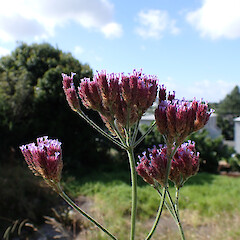Verbena bonariensis
Common name
purple-top, purple-top vervain
Synonyms
Verbena bonariensis var. conglomerata Briq.,Verbena intercedens Briq., Verbena inamoena Briq. Bull., Verbena bonariensis var. hispida Moldenke.
Family
Verbenaceae
Flora category
Vascular – Exotic
Structural class
Herbs - Dicotyledons other than Composites
NVS code
The National Vegetation Survey (NVS) Databank is a physical archive and electronic databank containing records of over 94,000 vegetation survey plots - including data from over 19,000 permanent plots. NVS maintains a standard set of species code abbreviations that correspond to standard scientific plant names from the Ngä Tipu o Aotearoa - New Zealand Plants database.
VERBON
Conservation status
Not applicable
Brief description
Verbena bonariensis is easily recognisable, the long floral tubes are conspicuous, even in the herbarium. Upon seeing the prominent flowers, examine the peduncles and calyx with a lens to confirm the presence of glandularity. The difference in leaf morphology also can be confirmed with a small set of specimens - leaves of V. bonariensis tend to be narrower than in V. incompta. In addition to the distinctions in the key, in V. bonariensis the non-glandular hairs are thinner and the plants apparently are generally shorter in stature and more clearly annual in duration. Described differences in shape and size of the inflorescence do not appear to be consistent, except in the elongation of fruiting spikes. Within each species, South American plants are similar in variability to the North American ones.
Distribution
North Island: South Island: True V. bonariensis is mostly seen as a weedy garden escape in cities such as Auckland and Christchurch.
Introduced in North America, Asia, Africa, Indian Ocean Islands (Mauritius), Pacific Islands, Australia.
Habitat
A seemingly uncommon species in the wild; found naturalising mostly close to gardens and old settlements.
Widely planted for insect food in gardens.
Wetland plant indicator status rating
Information derived from the revised national wetland plant list prepared to assist councils in delineating and monitoring wetlands (Clarkson et al., 2021 Manaaki Whenua – Landcare Research Contract Report LC3975 for Hawke’s Bay Regional Council). The national plant list categorises plants by the extent to which they are found in wetlands and not ‘drylands’. The indicator status ratings are OBL (obligate wetland), FACW (facultative wetland), FAC (facultative), FACU (facultative upland), and UPL (obligate upland). If you have suggestions for the Wetland Indicator Status Rating, please contact: [Enable JavaScript to view protected content]
FACU: Facultative Upland
Occasionally is a hydrophyte but usually occurs in uplands (non-wetlands).
Detailed description
Plants annual, taprooted or with ligneous fibrous roots. Stems erect, 80–150 cm, hirsute to hirsutulous, densely so distally, sparsely to densely stipitate-glandular. Leaves persistent, basal and midstem oblong-lanceolate to oblong-oblanceolate, basally clasping and auriculate, 5–11 cm x 10–20 mm, distal (above midstem) becoming linear-lanceolate to linear-oblanceolate, veins impressed adaxially, both surfaces hirsutulous to hirsute-hirsutulous or hirtellous, usually sparsely to densely stipitate-glandular, margins sharply serrate, narrowly revolute; petioles absent. Spikes in 3s, forming compound cymes, the central mostly sessile on peduncles 0(–4) mm, inflorescence aspect corymbiform, comprising relatively compact and distinct clusters and subclusters, central and laterals dense and thick in fruit, 8–30 mm x 4–6 mm; floral bracts narrowly triangular to lanceolate or ovatelanceolate, keeled, 2.1–2.8 mm, 1/2–3/4 as long as the calyces, margins eciliate. Calyces 3–3.5 mm, purplish, hirsutulous to hirsutulous-hirtellous or hirtellous, stipitate-glandular, lobes connivent. Corollas purple to blue-violet or pinkish, tubes 4–6(–7) mm, 1.5–2 mm longer than the calyces, limbs 2–5 mm in diam. Nutlets 1.5–1.9 mm, commissural faces extending to very tip of nutlets, densely papillate to papillate-bullate. 2n = 12, 14, 28.
Similar taxa
Verbena bonariensis is very similar to V. incompta and the two species have long been confused. The flowers differ between these species, V. bonariensis has exserted, broader corollas and the leaves of V. bonariensis tend to be narrower than in V. incompta. In addition to the distinctions in the key, in V. bonariensis the non-glandular hairs are thinner and the plants apparently are generally shorter in stature and more clearly annual in duration.
Flower colours
Violet/Purple
Year naturalised
1871
Origin
Native to South America (southern Brazil, Uruguay, Paraguay, northern Argentina).
Attribution
Fact sheet prepared by Marley Ford (5 March 2022). Brief description, Distribution and similar taxa sections are copied from Nesom (2010).
References and further reading
Ford M. (2022). Verbena incompta P.W.Michael: an overlooked name for an old weed in New Zealand. New Zealand Journal of Botany: 1–11. (Published online: 23 May 2022)
Nesom G.L. (2010). Taxonomic notes on Verbena bonariensis (Verbenaceae) and related species in the USA. Phytoneuron 12: 1–16.


















